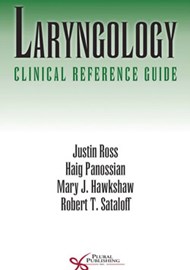On receiving this book, it was rather reminiscent of preparing for my FRCS as it is from the series of the infamous ‘Pasha’. It is therefore laid out in the same manner i.e. thin pages and more text than pictures. This equates to 503 pages packed full of laryngology. The editors and authors are well known in laryngology circles, especially Robert Sataloff.
It is divided into 10 sections with a total of 38 chapters covering all aspects of laryngology, from history and embryology to voice and swallow. Each chapter is of varying length but generally short enough to be concise whilst maintaining interest. From an FRCS perspective, the section on laryngologic disorders is very well written and covers above and beyond what is required in the viva section of the exam. I particularly enjoyed reading the chapter on laryngotracheal trauma and premalignant lesions of the larynx.
There is a 30-page section on neurolaryngology. This short section is informative and gives a good summary of neurophysiology, dystonias and vocal fold paresis. It is a good starting point for a laryngologist in waiting and can be used as a foundation to build further knowledge.
Detailed surgical techniques are beyond the intended scope of this book and therefore not really described but it does have the basics e.g. laser physics, different laryngoscope types and injectable materials. In-depth operative techniques need to be acquired from elsewhere.
Swallowing disorders are covered towards the end of the book; this again is very concise and to the point and is enough for a generalist or a trainee but not a consultant with an interest in swallow.
Overall, I would summarise this book by saying it a very useful review book/portable pocket guide. It is more aimed at trainees and definitely serves a purpose and fills a void that previously existed.




